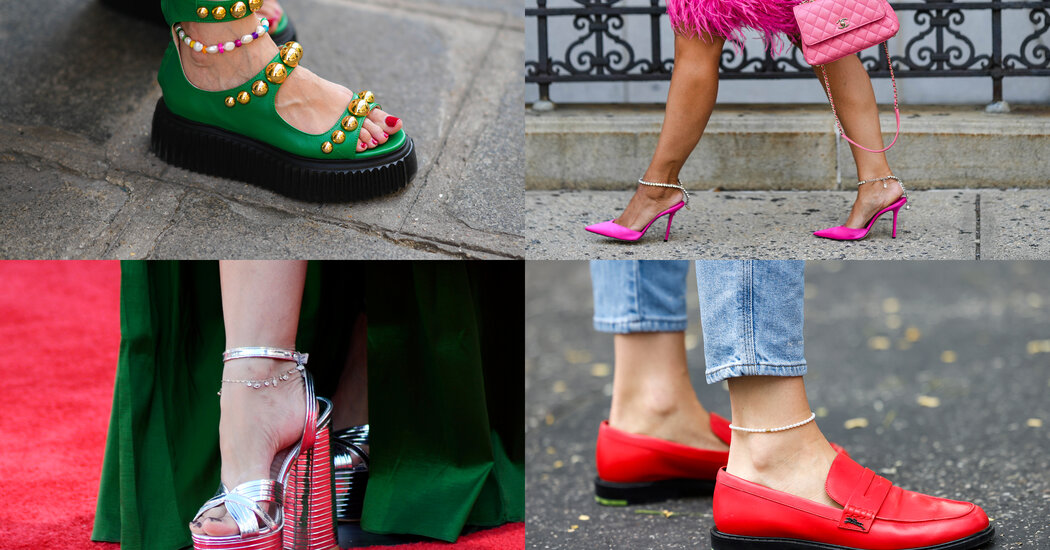During Dior’s high jewelry presentation in June, a model walking down the stairs of the Villa Erba on Italy’s Lake Como wore two earrings, an ear cuff, a choker, two rings on each of her forefingers and, tied around her right ankle, a bouquet of diamond blossoms on a fabric strap.
“It was very much about using the body as a playground — from ear cuffs to anklets,” Victoire de Castellane, Dior Jewelry’s creative director, wrote in an email about the house’s newest collection, Les Jardins de la Couture.
Anklets have been a mainstay for centuries in the Middle East and Southeast Asia, but they weren’t popular in the West until the mid-20th century, and even then mostly as a teen fad or a playful adornment for a day at the beach.
In recent years, however, designers have been experimenting with the style. The Paris-based designer Valérie Messika has included anklets in most of the collections she has presented since opening her namesake diamond-focused brand in 2005, and in 2021 she collaborated with Kate Moss on an anklet design. “Jewelry shouldn’t be limited to our fingers, wrists, necks and ears,” Ms. Messika wrote in an email. “I love being creative with wearing my jewelry on the body, and an anklet gives an elegant-cool finish.”
Ms. Messika’s sentiments were echoed at recent red-carpet events, like Dolce & Gabbana’s haute couture event last month in Puglia, Italy, where Kim Kardashian wore her own diamond anklet to accent an opulent purple gown. And in November, Lucia Silvestri, Bulgari’s jewelry executive creative director, wore a diamond-studded Serpenti bracelet around her ankle at the London opening of “Serpenti Metamorphosis,” an exhibition celebrating the 75th anniversary of the house’s hallmark reptile design.
“There is definitely an increase in the offer of ‘high-end’ anklets,” Alyse Chirumbole, director of fine jewelry and watches for the online personal-shopping service Threads Styling, said. And even though anklets are being worn all year, she added, their sales spike between early spring and late summer in the Northern Hemisphere — and that’s not including the bracelets or necklaces that shoppers buy to adapt.
When Sabine Getty, a socialite and British Tatler’s editor-at-large, posted on Instagram a photograph from her holiday this summer in Greece, it included her favorite gold Payal anklet by Venyx. “I wear it every day all summer,” she said in a phone interview, “and in the winter, I love to wear it over black tights at formal events, just to make the look a bit more fun and sexier.”
Eugenie Niarchos, the founder and designer of Venyx, began designing anklets about six years ago and introduced the Payal line when she opened a pop-up store on the Greek island of Mykonos in 2020, initially making them in 18-karat gold and then switching to 14 karat to reduce their weight (2,400 pounds, or $3,060). Ms. Niarchos said the collection’s name, Payal, referred to the Hindi word for anklet.
Venyx also offers the 18-karat-gold Big Pearl Anklet, with 31 pink pearls (£1,200), the silver Mykonos Shell design (£585) and a children’s version of the 14-karat Payal (£1,980).
Ms. Niarchos said she had posted pictures of herself wearing her anklets with the hashtag #wearyourankletsalldayeveryday. She began noticing how “customers become so attached to them they hardly remove them,” she said. “Some of them even keep them on in the winter.”
“Previously, the trend was to wear anklets tight and sit high up around the ankle, and usually just around one ankle,” she noted. “However, my designs are made to sit low, below the fibula, to add some shine around the top of the foot.”
Historically, the custom of wearing anklets was well-documented among the Egyptians, Greeks and Romans, said Nikita Binani, Sotheby’s head of jewelry sales in London. And in India, she added, “anklets have been continuously worn and have traditionally been a sign of wealth and status both for men and women.”
The payal anklet, also known as a paijeb and a paizeb, is a gift offered to brides to wish them prosperity and to ward off the evil eye, Ms. Binani said. The designs often are lavishly decorated, like the anklet laden with table-cut diamonds or the pair featuring antique enamel work and green glass drops that were sold by Christie’s at its 2019 auction, Maharajas & Mughal Magnificence.
Ms. Binani, who trained to be a professional dancer in India, described an anklet known as a ghungroo, which can have multiple strands reaching up to the calf, weigh as much as a kilogram (2.2 pounds) and, crucially, have plenty of beads whose jingle becomes part of the music: “It brings together music, dance, jewelry — all in one.”
Krishna Choudhary, the designer of the London-based Santi Jewels, said that anklets were frequently mentioned in Indian literature, even in the sacred texts of Buddhism, and are part of the 16 traditional embellishments that a Hindu woman is expected to wear. For example, Mr. Choudhary said, “My mother offered anklets to my wife as a wedding present.”
While jewelers in the West have begun to offer specific designs, Francesca Ruggiero, the founder and designer of the jewelry brand Kiaia, in London, said most clients simply bought a bracelet or a necklace and wear it around the ankle.
Ms. Ruggiero said a sales assistant at the brand’s pop-up store on Capri, in Italy, this summer saw a client buy a 22-karat gold Kiaia Snake necklace (from €2,100) and immediately put it around her ankle.
Lily Gabriella Elia, a fine jewelry designer based in London, said the first anklet she made was in 2019 for a Brazilian client who also commissioned a matching armlet, but most of the clients requesting anklets come from the Middle East.
“At the beginning,” she said, “we were doing more classic tennis-bracelet style set with sapphires, however, now it is the Talisman collection with a customizable evil eye that is more successful.” (Pieces in the collection start at £1,250)
And Mizuki Goltz, the Tokyo-born designer of Mizuki, the fine jewelry line in New York, said she believed the current popularity of anklets reflected a refound focus on self-care and well-being that began during the pandemic.
“I like to think of my anklets as lingerie. The power of lingerie is not about showing, but it’s about knowing that your ankle looks pretty and sexy even under a long skirt or pants,” she said. “It always adds something special whether you see it or not.”
Sumber: www.nytimes.com










